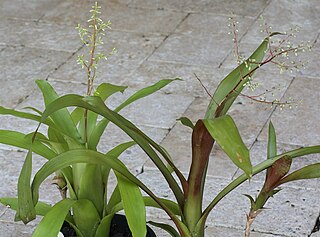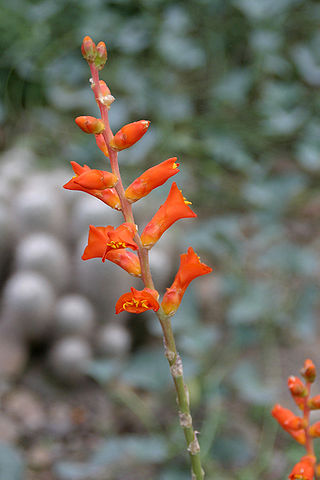
Araeococcus is a genus of the botanical family Bromeliaceae, subfamily Bromelioideae. It is native to northern South America, Central America and Trinidad.

Nidularium is a genus in the plant family Bromeliaceae, subfamily Bromelioideae. Named to describe the nestling characteristic of the inflorescence, all the species are endemic to Brazil. Commonly confused with Neoregelia which they resemble, this plant group was first described in 1854.

Dyckia leptostachya is a plant species in the genus Dyckia. This species is native to Brazil, Bolivia, Paraguay, and Argentina.
Aechmea alba is a species of plant in the genus Aechmea. This species is endemic to Brazil.
Nidularium antoineanum is a plant species in the genus Nidularium. This species is endemic to Brazil.
Nidularium ferdinando-coburgii is a plant species in the genus Nidularium. This species is endemic to Brazil.

Aechmea emmerichiae is a species of flowering plant in the genus Aechmea. This species is endemic to Chapada Diamantina National Park in eastern Brazil.
Aechmea organensis is a plant species in the genus Aechmea. This species is endemic to southeastern Brazil.

Aechmea purpureorosea is a plant species in the genus Aechmea. This species is endemic to southeastern Brazil, States of Minas Gerais and Rio de Janeiro.

Alcantarea geniculata is a plant species in the genus Alcantarea. This species is endemic to Brazil.
Pseudaraeococcus montanus is a species of flowering plant in the family Bromeliaceae, endemic to Brazil. It was first described in 1999 as Araeococcus montanus.
Pseudaraeococcus nigropurpureus is a species of flowering plant in the family Bromeliaceae, endemic to Brazil. It was first described in 2007 as Araeococcus nigropurpureus.

Pseudaraeococcus parviflorus is a species of flowering plant in the family Bromeliaceae, endemic to Brazil. It was first described in 1830 as Billbergia parviflora.
Pseudaraeococcus sessiliflorus is a species of flowering plant in the family Bromeliaceae, endemic to Brazil. It was first described in 2007 as Araeococcus sessiliflorus.
Quesnelia augustocoburgii is a species of flowering plant in the family Bromeliaceae, endemic to Brazil. It was first described by Heinrich Wawra von Fernsee in 1880. It is found in the Atlantic Forest ecoregion of southeastern Brazil. The name is sometimes spelt with a hyphen as Quesnelia augusto-coburgii.
Quesnelia blanda is a species of flowering plant in the family Bromeliaceae, endemic to southeastern Brazil. It was first described in 1856 as Bromelia blanda. As of November 2022, the Encyclopaedia of Bromeliads listed it under the synonym Quesnelia strobilospica, which it spelt Quesnelia strobilispica.

Vriesea wawrana is a plant species in the genus Vriesea. This species is endemic to Brazil.

Tillandsia geminiflora is a species in the genus Tillandsia. This species is native to Brazil, Suriname, Paraguay, Uruguay, and the Misiones Province of Argentina.

Dyckia rariflora is a plant species in the genus Dyckia endemic to the State of Minas Gerais in Brazil.
Pseudaraeococcus is a genus of flowering plant in the family Bromeliaceae, native to northeastern Brazil. It was first described as the subgenus Pseudaraeococcus of the genus Araeococcus by Carl Christian Mez in 1935, and raised to a separate genus in 2020.









